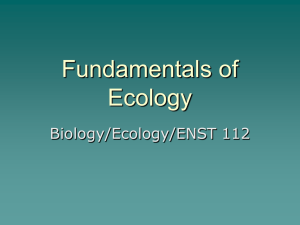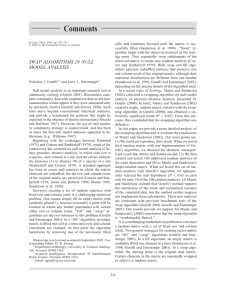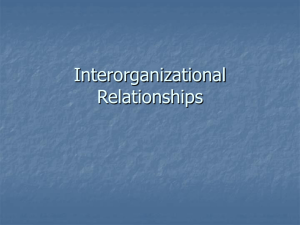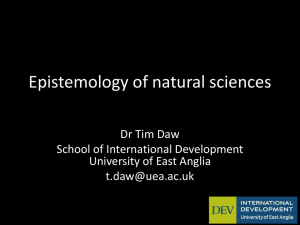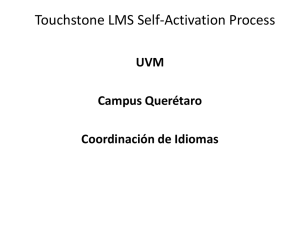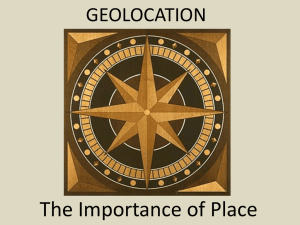pptx
advertisement
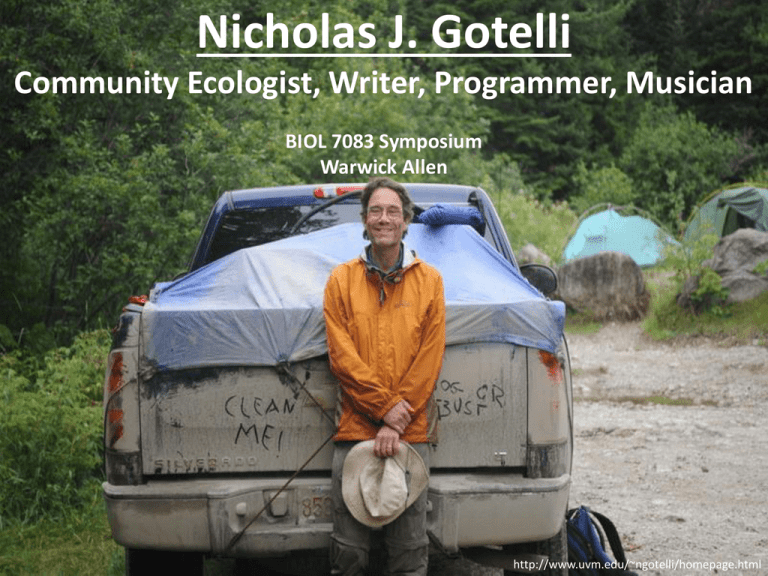
Nicholas J. Gotelli Community Ecologist, Writer, Programmer, Musician BIOL 7083 Symposium Warwick Allen http://www.uvm.edu/~ngotelli/homepage.html “I don’t do my work in order to persuade people to conserve pitcher plants. As far as my work goes, I am ultimately a hedonist. The real reason I do my work is that I love it, and it’s intellectually satisfying to me. Everything else follows secondarily.” Outline • • • • Background Pitcher plant communities Biometrics Music! http://www.uvm.edu/~ngotelli/musicpage/Kaspari/Kaspari.html Education • Ph.D. – Florida State University. 1982 – 1985 (advisor: Dan Simberloff) • M.S. – Florida State University. 1980 – 1982 (advisor: Lawrence Abele) • B.A. – University of California, Berkley. 1976 – 1980 http://www.skylinepictures.com/Florida_State_University_fs7_full.htm Appointments • 2000 - present. Full Professor, Department of Biology, University of Vermont • 2008 - 2010. Adjunct Professor, Xishuangbanna Tropical Botanical Garden, Chinese Academy of Sciences • 1995 - 2000. Associate Professor, Department of Biology, University of Vermont • 1992 - 1994. Assistant Professor, Department of Biology, University of Vermont • 1988 - 1992. Assistant Professor, Department of Zoology, University of Oklahoma • 1987 - 1988. Post-doctoral Associate, Department of Biology, Colorado State University • 1985 - 1987. Lecturer, Department of Organismic and Evolutionary Biology, Harvard University Teaching Interests • Theoretical, Community, Population, and Experimental Ecology • Ecological Modeling • Biostatistics • Biogeography • Invertebrate Zoology http://www.uvm.edu/~intbiosc/?Page=Discover.html&SM=discovermenu.html Research Interests • • • • • • • • • Food-webs Community structure Altered nutrient regimes Extinction risk Invasive species Biogeography Ecological statistics Null models Software development http://biogeography.blogspot.com/2008/10/hypothesis-testing-curve-fitting-and.html Food Webs “So the other direction that food web analysis has gone – that to me is much more satisfying – is to deliberately simplify and collapse all that complexity; to deliberately distort nature and pigeonhole it into a couple of key little trophic groups of predators or consumers or parasitoids and work out the critical linkages there” Purple pitcher plant (Sarracenia purpurea) http://highlandsbiological.org/tag/highlands-botanical-garden/ http://www.youtube.com/watch?v=bqxy0ydJMpY http://www.uvm.edu/~ngotelli/researchpage/Research.html Ideal study system: • Perfect for small scale manipulative experiments • Complete and selfcontained • Relatively simple (five trophic levels) http://www.montegraphia.com/?tag=triangle-lake-bog Food Webs Insight into important ecological topics: • Top-down vs bottom-up forces • Trophic cascades • Community assembly rules • Extinction risk http://hortlog.blogspot.com/2007_11_01_archive.html Food Webs A Series of Sarracenia Experiments • Sprayed nitrogen and phosphorous on pitcher plant bogs to examine how this alters morphology (relative keel size and relative tube diameter) • Measured changes in photosynthesis, flowering, and population growth rates • Examined effects of prey additions, pitcher volume alterations, and removal of top trophic level consumers • Patterns in biodiversity also investigated • Increased anthropogenic nitrogen from “acid rain” changed leaf type from pitcher to phyllode leaves Ellison & Gotelli, 2002a http://www.uvm.edu/~ngotelli/researchpage/Research.html • Photosynthesis and ability to flower increased, but population growth rate decreased • Increased nitrogen leads to higher extinction risk Ellison & Gotelli, 2002b • Interestingly, increased nutrient input from prey had no effect on morphology, growth rate or photosynthesis, but changed levels of elements in plant tissue • Inquiline communities nitrogen input is relatively low in comparison to that from the atmosphere • May provide a reliable biological indicator of atmospheric nitrogen deposition and saturation in communities Wakefield et al., 2005 • Just begun publishing his work at the community level • Reverse latitudinal trend in species richness (highest in northern sites), perhaps mediated by top-down processes • Local (within population) variation in food web structure is higher than continental variation • Development of speciesspecific proteomic indicators to determine ecosystem health Buckley et al., 2003; Buckley et al., 2010; Gotelli et al., 2011 • Changes in food web structure is predicted best by trophic structure models as opposed to keystone species or habitat models • Important to look at a wide range of trophic interactions in order to properly understand what is occurring in a system • Consequences for predicting effects of climate change, habitat destruction, and invasive species Gotelli & Ellison, 2006 Books A Primer of Ecology • Read by many students and recommended in many ecology courses • An excellent introduction to ecology • Particular focus on mathematics/modelling http://www.bioquip.com/html/view_prodpics.asp?CatalogNum=3994C Statistics Ecological Statistics • Published in collaboration with Aaron Ellison • Part 1: Probability & statistical thinking • Part 2: Experimental design • Part 3: Common ecological analyses http://product.51eng.com/9780878932696/A-Primer-Of-Ecological-Statistics.html Quantifying Biodiversity: Procedures and Pitfalls in the Measurement And Comparison Of Species Richness • Co-authored by Robert Colwell • 1,519 citations • Rarefaction or asymptote estimation allows for meaningful comparisons of species richness • Led to development of EstimateS software • New paper (March 2012) provides an update: “Models and estimators linking individual-based and sample-based rarefaction, extrapolation and comparison of assemblages” Statistics Null Models • “We always have to ask ‘patterns compared to what?’ In the absence of an experimental data set (and most data sets in ecology are not based on experiments), we have to have some base level against which we compare patterns” • Free download online! http://vertebrates.si.edu/birds/birds_staff_pages/Garygraves_Nullmodelsbook.html • A strong proponent for the use of null models in ecology for examining community level processes • Has published numerous papers on the subject as well as his book • What is a null model? • A model built around randomizations of known or imagined ecological data but with the absence of a particular ecological mechanism • Often used to compare results against a model which includes the mechanism (i.e. is a pattern deterministic or stochastic?) • Gotelli provides a highly-cited review of the main uses of null models in ecology: 1. Biodiversity measures (rarefaction) 2. Species co-occurrence patterns (detection of species interactions) 3. Macroecology (identify constraining boundaries in bivariate scatterplots) Gotelli, 2001 • • • • Application of null models: Meta-analysis examining Jared Diamond’s assembly rules model (1975) Less co-occurrence of species than expected by chance Non-random structure greater for homeotherms than poikilotherms Demonstrates the power of using null models in community ecology Gotelli & McCabe, 2003 Statistics Null Models/Ecosim • EcoSim: null models software for ecology • Developed in collaboration with Gary Entsminger • Creates null models to look at: - Co-occurrence patterns - Niche overlap - Species diversity - Macroecological patterns • EcoSimR currently being built Other Software BioGeoSim • BioGeoSim: Biogeography software for ecologists • Developed with Gary Entsminger, Carsten Rahbek, and Gary Graves • Used to analyze observed species ranges against stochastic/null models and environmental variables Music • • • • • • • Easy Wind The Littlest Birds Gypsy Affair Jawless Fishes Kesey Bear Band Touch of Grey Many others… • ESA meetings – The Hot Club http://www.uvm.edu/~ngotelli/musicpage/Simberloff/Simberloff.html http://www.uvm.edu/~ngotelli/musicpage/LittlestBirds/LittlestBirds.html Thanks! http://www.uvm.edu/~ngotelli/musicpage/music.html References BIOL 7083 REFERENCES USED FOR NICK GOTELLI PRESENTATION Buckley, H. L., Miller, T. E., Ellison, A. M. & Gotelli, N. J. (2010) Local- to continental-scale variation in the richness and composition of an aquatic food web. Global Ecology and Biogeography, 19, 711-723. Buckley, H. L., Miller, T. E., Ellison, A. M. & Gotelli, N. J. (2003) Reverse latitudinal trends in species richness of pitcher-plant food webs. Ecology Letters, 6, 825-829. Colwell, R. K., Chao, A., Gotelli, N. J., Lin, S-Y., Mao, C. X., Chazdon, R. L. & Longino, J. T. (2012) Models and estimators linking individual-based and sample-based rarefaction, extrapolation and comparison of assemblages. Journal of Plant Ecology, 5, 3-21. Ellison, A. M. & Gotelli, N. J. (2002a) Nitrogen availability alters the expression of carnivory in the northern pitcher plant, Sarracenia purpurea. PNAS, 99, 4409-4412. Ellison, A. M. & Gotelli, N. J. (2002b) Nitrogen deposition and extinction risk in the northern pitcher plant, Sarracenia pupurea. Ecology, 83, 2758-2765. Gotelli, N. J. (2001) Research frontiers in null model analysis. Global Ecology and Biogeography, 10, 337-343. References Gotelli, N. J. (2008) A Primer of Ecology, Fourth Edition. Sinauer Associates Inc., Sunderland, Massachusetts. 291p. Gotelli, N. J. & Colwell, R. K. (2001) Quantifying biodiversity: procedures and pitfalls in the measurement and comparison of species richness. Ecology Letters, 4, 379-391. Gotelli, N. J. & Ellison, A. M. (2004) A Primer of Ecological Statistics. Sinauer Associates Inc., Sunderland, Massachusetts. 479p. Gotelli, N. J. & Ellison, A. M. (2006) Food-web models predict species abundances in response to habitat change. PLOS Biology, 4, 1869-1873. Gotelli, N. J. & Graves, G. R. (1996) Null Models in Ecology. Smithsonian Institution Press, Washington D. C. 368p. Gotelli, N. J. & McCabe, D. J. (2002) Species co-occurrence: a meta-analysis of J. M. Diamond’s assembly rules model. Ecology, 83, 2091-2096. Gotelli, N. J., Smith, A. M., Ellison, A. M. & Ballif, B. A. (2011) Proteomic characterization of the major arthropod associates of the carnivorous pitcher plant Sarracenia purpurea. Proteomics, 11, 2354-2358. References Wakefield, A. E., Gotelli, N. J., Wittman, S. E. & Ellison, A. M. (2005) Prey addition alters nutrient stoichometry of the carnivorous plant Sarracenia purpurea. Ecology, 86, 1737-1743. INTERNET LINKS Gotelli Website - http://www.uvm.edu/~ngotelli/homepage.html ESA Interview - http://sarcozona.org/2011/08/22/esa-interviews-nick-gotelli/
